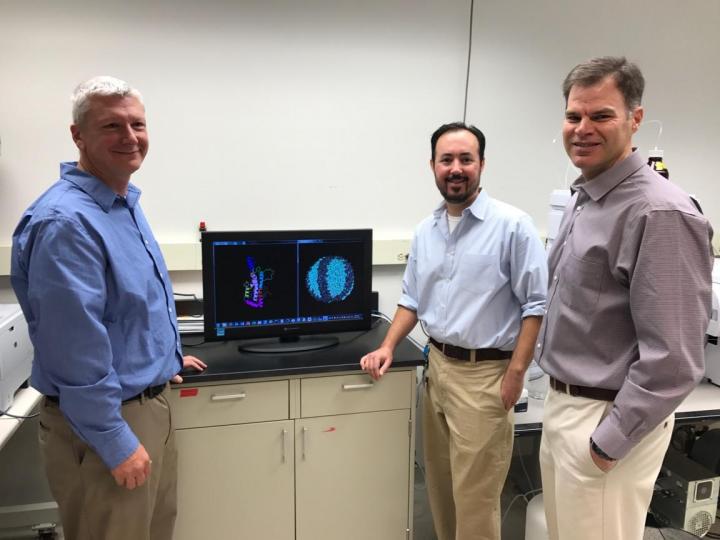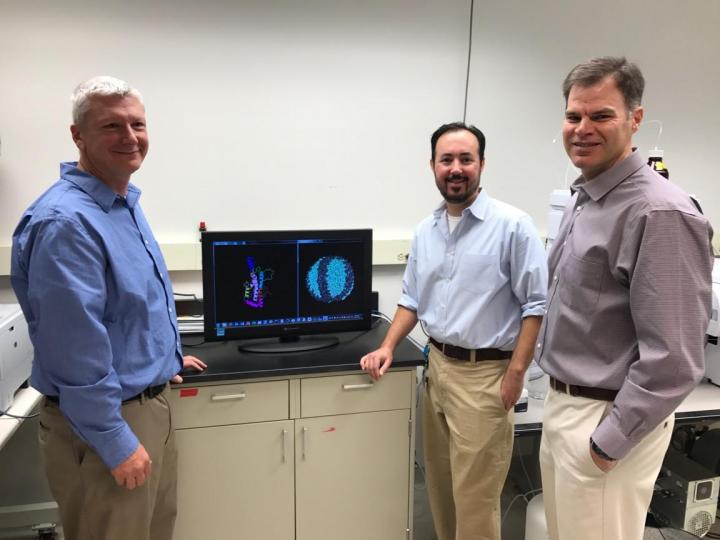
Credit: University of Cincinnati
CINCINNATI — After decades of individual attempts to identify the structure of the main building block of HDL (high-density lipoproteins), the so-called "good" cholesterol that associates with protection from cardiovascular disease, a research team representing eight academic institutions across the U.S. and Australia has come to agreement on a predictive model.
Their study, "A Consensus Model of Human Apolipoprotein A-I in its Monomeric and Lipid-Free State" is currently available online in the journal Nature Structure and Molecular Biology.
"We are excited to finally have a robust picture of what this protein looks like," says Sean Davidson, PhD, professor and vice chair in the Department of Pathology and Laboratory Medicine at the University of Cincinnati (UC) College of Medicine, and the corresponding author on the study.
Davidson and John Melchior, PhD, a UC postdoctoral fellow, organized a working group of leading lipid structural biologists to attack a fundamental issue in the field of fat metabolism. "All of us, including myself, have been chipping away at the edges of this problem for decades," says Davidson, adding that the protein simply doesn't respond to the typical methods used to model other protein structures.
Thus, the working group took a novel approach: they combined data from a variety of indirect experimental techniques from different laboratories to develop a consensus model. The breakthrough took over a year of intense cooperation among scientists who are normally in friendly competition. "This study was a unique collaborative experience for me. People from all over the U.S. and Australia freely shared what amounts to a couple of centuries (or more) of collective expertise and knowhow to come up with a definitive insight into apoA-I structure." says Kerry Anne-Rye, PhD, a co-author from the University of New South Wales in Australia.
A second factor, low-density lipoprotein (LDL), has been called "bad" cholesterol and can be harmful. While the body needs some cholesterol to function, when levels of LDL get too high, fatty deposits can accumulate in blood vessels. This causes them to narrow, leading to heart attacks, strokes or other serious vascular problems. HDL is thought to work against this accumulation.
Anchored by work that was awarded the Nobel Prize in 1985, the metabolism of LDL is well understood. This spurred the development of a class of drugs called statins which reduce "bad" cholesterol. However, the biology of HDL has been more elusive and this has complicated the development of HDL targeted drugs, says Davidson. "Our work, combined with the structure of a critical cell protein that helps assemble HDL published earlier this year, finally gives us the tools to propose and test hypotheses on how HDL is generated."
###
Also participating in the study were researchers Allison Cooke, Mark Castleberry and Jamie Morris from Davidson's laboratory. The working group included Ryan Walker and Tom Thompson, PhD, from the Department of Molecular Genetics Biochemistry and Microbiology at UC; Martin Jones, Hyun Song, PhD, and Jere Segrest, MD, PhD, from Vanderbilt University; Michael Oda, PhD, from Children's Hospital Oakland Research Institute; Mary Sorci-Thomas, PhD, and Michael Thomas, PhD, from the Medical College of Wisconsin; Jay Heinecke, MD, from the University of Washington; Xiaohu Mei, PhD, and David Atkinson, PhD, from Boston University; and Michael Phillips, PhD, and Sissel Lund-Katz, PhD, from the University of Pennsylvania.
This work was supported by an American Heart Association postdoctoral fellowship grant (16POST27710016 to Melchior), the National Heart, Lung, and Blood Institute of the National Institutes of Health (NIH) funded pre-doctoral fellowship to Castleberry (HL125204-03), R01 HL127649 to Davidson, R01 HL127649 to Sorci-Thomas, P01 HL026335 and R01 HL116518 to Atkinson, P01 HL12803 to Davidson, Segrest and Heinecke. The mass spectrometry data was acquired in the UC Proteomics Laboratory under the direction of Ken Greis, PhD, on a mass spectrometer funded in part through an NIH S10 shared instrumentation grant (RR027015 Gries).
The authors have no conflicts of interest to report for this work
Media Contact
Angela Koenig
[email protected]
513-368-5801
@UCHealthNews
http://www.healthnews.uc.edu
Original Source
http://healthnews.uc.edu/news/?/29563/






